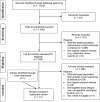A systematic review and meta-analysis of the direct epidemiological and economic effects of seasonal influenza vaccination on healthcare workers
- PMID: 29879206
- PMCID: PMC5991711
- DOI: 10.1371/journal.pone.0198685
A systematic review and meta-analysis of the direct epidemiological and economic effects of seasonal influenza vaccination on healthcare workers
Abstract
Background: Influenza vaccination is a commonly used intervention to prevent influenza infection in healthcare workers (HCWs) and onward transmission to other staff and patients. We undertook a systematic review to synthesize the latest evidence of the direct epidemiological and economic effectiveness of seasonal influenza vaccination among HCW.
Methods: We conducted a systematic search of MEDLINE/PubMed, Scopus, and Cochrane Central Register of Controlled Trials from 1980 through January 2018. All studies comparing vaccinated and non-vaccinated (i.e. placebo or non-intervention) groups of HCWs were included. Research articles that focused on only patient-related outcomes or monovalent A(H1N1)pdm09 vaccines were excluded. Two reviewers independently selected articles and extracted data. Pooled-analyses were conducted on morbidity outcomes including laboratory-confirmed influenza, influenza-like illnesses (ILI), and absenteeism. Economic studies were summarized for the characteristics of methods and findings.
Results: Thirteen articles met eligibility criteria: three articles were randomized controlled studies and ten were cohort studies. Pooled results showed a significant effect on laboratory-confirmed influenza incidence but not ILI. While the overall incidence of absenteeism was not changed by vaccine, ILI absenteeism was significantly reduced. The duration of absenteeism was also shortened by vaccination. All published economic evaluations consistently found that the immunization of HCW was cost saving based on crude estimates of avoided absenteeism by vaccination. No studies, however, comprehensively evaluated both health outcomes and costs of vaccination programs to examine cost-effectiveness.
Discussion: Our findings reinforced the influenza vaccine effects in reducing infection incidence and length of absenteeism. A better understanding of the incidence of absenteeism and comprehensive economic program evaluations are required to ensure the best possible management of ill HCWs and the investment in HCW immunization in increasingly constrained financial environments. These steps are fundamental to establish sustainability and cost-effectiveness of vaccination programs and underpin HCW immunization policy.
Conflict of interest statement
The authors have declared that no competing interests exist.
Figures







References
-
- Meara MO, Brien AO, Feely E, Conlon M. Influenza A outbreak in a community hospital. Ir Med J. 2006;99(6):175–7. - PubMed
-
- Pollara CP, Piccinelli G, Rossi G, Cattaneo C, Perandin F, Corbellini S, et al. Nosocomial outbreak of the pandemic Influenza A (H1N1) 2009 in critical hematologic patients during seasonal influenza 2010–2011: Detection of oseltamivir resistant variant viruses. BMC Infect Dis. 2013;13(1):127 10.1186/1471-2334-13-127 - DOI - PMC - PubMed
-
- Mitchell R, Huynh V, Pak J, Thompson S. Influenza outbreak in an Ontario long-term care home—January 2005. Can Commun Dis Rep. 2006;32(24):12. - PubMed
-
- Hansen S, Stamm-Balderjahn S, Zuschneid I, Behnke M, Rüden H, Vonberg RP, et al. Closure of medical departments during nosocomial outbreaks: data from a systematic analysis of the literature. J Hosp Infect. 2007;65(4):348–53. 10.1016/j.jhin.2006.12.018. 10.1016/j.jhin.2006.12.018 - DOI - DOI - PMC - PubMed
Publication types
MeSH terms
Substances
LinkOut - more resources
Full Text Sources
Other Literature Sources
Medical
Miscellaneous

